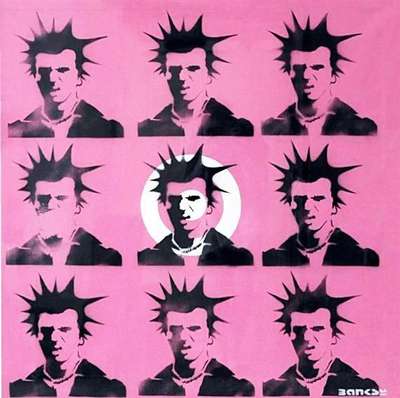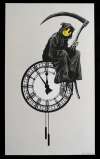Sid
Vicious
Banksy's Sid Vicious series pays tribute to the rebellious punk bassist of the Sex Pistols. The stencilled portrait is replicated across a grid, in a nod to Pop-Artist Warhol's serialisation that is redolent of police mugshots. The target superimposed centrally confirms Banksy’s exploration of the scrutiny that nonconformists are subject to by society.
Banksy Sid Vicious For sale
Sid Vicious Market value
Auction Results
| Artwork | Auction Date | Auction House | Return to Seller | Hammer Price | Buyer Paid |
|---|---|---|---|---|---|
 Sid Vicious Banksy Mixed Media | 5 May 2019 | Artcurial | £85,000 | £100,000 | £130,000 |
Sell Your Art
with Us
with Us
Join Our Network of Collectors. Buy, Sell and Track Demand
Meaning & Analysis
Sid Vicious - painted circa 2000 - might be one of Banksy’s first canvases, yet the work's format and vibrant colour palette sets it apart from much of the artist’s early output. A second print edition of Sid Vicious was made the same year; this includes a white 'target' symbol, spray-painted in the middle of the canvas as if someone were taking aim at the infamous punk rocker.
Here, Banksy pays tribute to Sid Vicious - onetime bassist and vocalist of the Sex Pistols - and Pop Art pioneer Andy Warhol. A key Warhol reference point is the Pop Artist's world-famous silkscreens: Banksy's sequence of nine Sid Vicious portraits, each replicated in a grid formation, is deliberately evocative of Warhol, whose similarly repetitive portraits of Pop culture icons like Marilyn Monroe (in Marilyn Diptych and Shot Marilyns), and Elvis Presley (in Elvis 21 Times and Eight Elvises) have become shorthand for the Pop Art movement.
Sid Vicious is the embodiment of the Punk subculture of the 1970s and 80s, his image a symbolic stand-in for a group of artists, musicians, and other members of the public who declared themselves as opposed to all things conventionional - especially mass-produced popular music and consumerism. The Punk movement was characterised by its anti-establishment views and a wish for individual freedom.
Whilst Warhol’s Marilyn Monroe-based series presents a critique of mass production and consumerism, Banksy's Sid Vicious pushes this concept further, using a well-known visual motif of Punk culture to question the cultural perspective of Pop Art whilst venerating the Punk musician and the Punk ideology.








